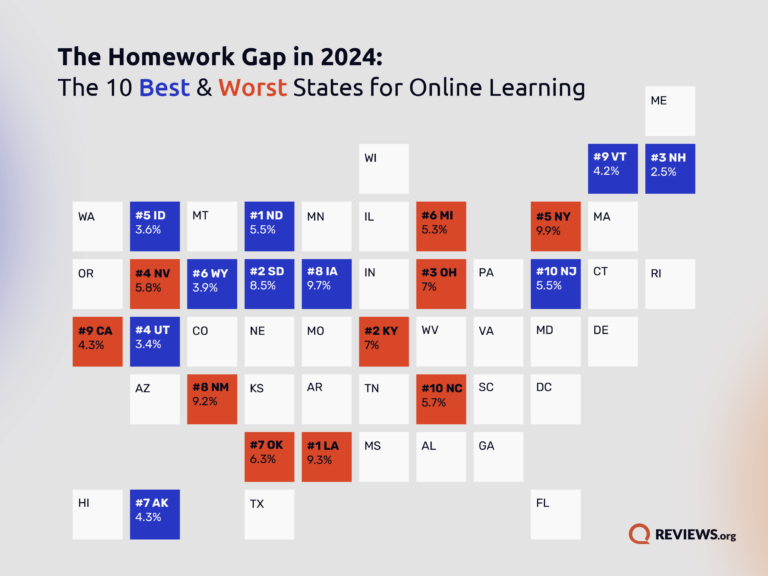Here’s how the loss of ACP funding affects the US students’ access to internet (and what to do about it)
Homework Gap Report: The 10 Best and Worst States for Online Learning
Funding for the federal government’s Affordable Connectivity Program is going to be completely out by the end of May—raising concerns about internet access for U.S. students and how they’re impacted by the “homework gap.”
The National Education Association calls the homework gap "the barriers students face when working on homework assignments without a reliable internet source at home."
Since 2021, the U.S. has made strides in closing the homework gap with assistance programs like the ACP, which provides up to $30 monthly toward internet payments. But without the programs, we suspect the gap to only worsen. We did a deep dive into how lack of ACP funding might affect students' homework completion and how to potentially overcome those obstacles.
Guide to online learning in the US:
Student internet access at a glance
In our deep dive into student internet access, we learned a few interesting facts:
- Nearly 3 million children (4.57%) in the U.S. don't have access to the internet.
- Almost 1 million children (27%) still don't have a computer at home.
- Only 27% of students under age 18 with no high-speed internet connection go on to complete a postsecondary program. That's in contrast to 96.66% of those with a high-speed internet connection.
- The states with the biggest homework gaps all have poverty rates of 8% or higher.
- The top 10 states with the biggest homework gaps relied on government-assisted internet programs with an enrollment rate of 36% or higher.
- 4% of households in the United States enrolled in the ACP.

Internet access has gone from a nice-to-have utility to a necessary utility. In a recent survey, 70% of Americans told Reviews.org that affordable internet access is essential to their daily lives.
“As a software dev, I can tell you that the internet is way more ingrained in every facet of our daily lives, more than we'll ever be able to gather. No internet means no opportunities,” says Sean Spittle, the lead software developer and managing partner at inspection software firm InspectNTrack.
However, the average internet connection costs $81 a month, or $972 a year. Unfortunately, not everyone has $1,000 to spare.
10 best states for online learning
Top 10 best states for online learning
In an unexpected win, rural North Dakota leads as the best state for online learning. Only 5.53% of North Dakotan households were enrolled in the ACP, and only 5.52% of individuals under 18 lack essential technology access.
New Hampshire follows closely, boasting a mere 2.50% of individuals under 18 without a computer and broadband subscription. North Hampshirites also enjoy a high average internet speed of 161Mbps.
Reviews.org's home state, Utah, also stands out with just 3.35% of individuals under 18 lacking necessary technology access and a solid average internet speed of 139Mbps.
10 worst states for online learning
Top 10 worst states for online learning
Going purely by the numbers, Louisiana leads as the worst state for online learning. A total 31.89% of Louisianan households were enrolled in the ACP. The end of ACP funds means nearly one-third of Louisianans may struggle to access affordable internet for remote education.
Nevada also stands out. It has the highest average internet speed (155Mbps) among the top 10 worst states. But despite good connectivity, Nevadans still have a high ACP enrollment rate. Part of this less-than-ideal online learning trend may be due to Nevada’s historic economic disparity across racial lines.
How to close the homework gap
Michael D. Smith, a professor of information technology at Carnegie University and author of the 2023 book The Abundant University: Remaking Higher Education for a Digital World, says that accessible internet is crucial to today’s educational setup, especially for those who’ve opted for online-only higher education. “Finding free Wi-Fi at a public library, or Panera, or a friend's house is nowhere near as convenient as having it at home,” Smith says.
Students need access to low-cost, accessible internet connections to complete their school work. A 2021 study in Ghana found “internet access influences academic standards among students, as those with internet access have shown a higher improvement in academic performance than those without.”
With that in mind, here are a few lower-cost internet options that might work for families with limited financial resources.
Not all of these plans are available everywhere, but most areas in the U.S. have access to at least one.
If you don’t live in an area with affordable internet, you might be able to use free public Wi-Fi hotspots. While these won’t work for every student, they’re a viable alternative to home internet access.
And although (as Professor Smith says) using Wi-Fi at a library, a friend's place, or a Panera is less convenient than internet in the home, lower-income families can take advantage of such resources in a pinch. According to the Pew Research Center, half of lower-income families using the library already report that their children visit to complete homework rather than to check out books or enjoy library programs.
Methodology
To source our list, we ranked each state’s online learning situation from best to worst using three factors.
- 33% of the score came from the percentage of students without home computer access or broadband subscriptions by state, according to the latest US Census data from the 2022 American Community Survey. Higher percentages of households with no broadband subscriptions positively impacted the score.
- 33% of the score came from the percentage of American households who enrolled in the Affordable Connectivity Program before the Universal Service Administrative Co. capped applicants in March 2024. Higher percentages of enrolled households positively impacted the score.
- 33% of the score came from the average internet speed by state from Reviews.org. Higher speeds negatively impacted the score.
Related Articles



